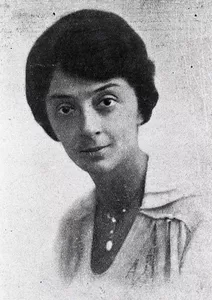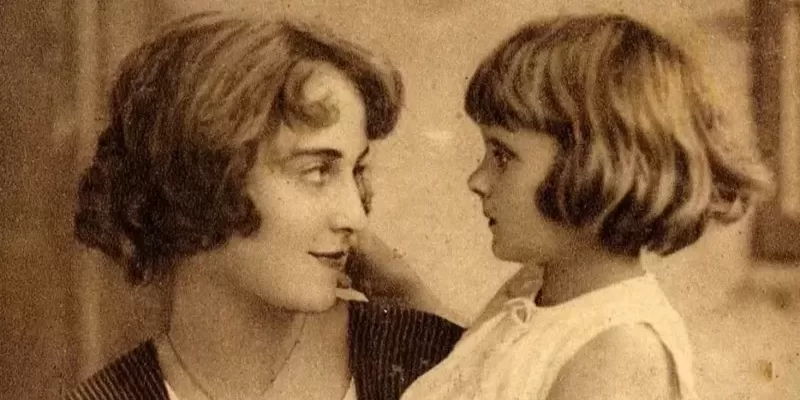From Australia’s Jewish Past:
On Mothers’ Day, a toast to mothers from times gone by
First published in J-Wire May 3, 2022
J-Wire salutes these women who played their part in shaping the Australia in which we live today.
 Gladys Marks was born in 1883 in Brisbane and by the 1920s was the first female lecturer in the Faculty of Arts as well as the first female to act as a head of a department at the University of Sydney in the 1920s. She went on to teach in private schools for girls before travelling through Europe and studying phonetics in Paris and London. Throughout her life, she supported women’s rights and was active in a range of feminist groups, including the National Council of Women of NSW. She attended the International Women’s Congress in Rome in 1914 and Copenhagen in 1924 and was President of the Australian Federation of University Women from 1930 to 1934. In 1962 she established the Gladys Marks Travelling Scholarship, which allowed students to study in France.
Gladys Marks was born in 1883 in Brisbane and by the 1920s was the first female lecturer in the Faculty of Arts as well as the first female to act as a head of a department at the University of Sydney in the 1920s. She went on to teach in private schools for girls before travelling through Europe and studying phonetics in Paris and London. Throughout her life, she supported women’s rights and was active in a range of feminist groups, including the National Council of Women of NSW. She attended the International Women’s Congress in Rome in 1914 and Copenhagen in 1924 and was President of the Australian Federation of University Women from 1930 to 1934. In 1962 she established the Gladys Marks Travelling Scholarship, which allowed students to study in France.
 Fanny Cohen was born in 1887 in Grafton NSW. She was an excellent student and in 1904 she passed the senior public examination with first-class honours and medals for mathematics, algebra and French. At the University of Sydney, she graduated with a B.A. followed by a B.Sc. where she achieved first-class honours in mathematics and geology, being awarded the university medal in geology. She went on to study mathematics at Cambridge and once back in Sydney became the assistant mistress of mathematics at Fort Street Girls’ High. In 1922 she was appointed deputy headmistress of North Sydney Girls’ High, the next year as headmistress of the Maitland West Girls’ High and in 1926 she became headmistress of St George Girls’ High. Her final school was Fort Street as its headmistress from 1920 to 1929. She was also a member of the Senate of the University of Sydney.
Fanny Cohen was born in 1887 in Grafton NSW. She was an excellent student and in 1904 she passed the senior public examination with first-class honours and medals for mathematics, algebra and French. At the University of Sydney, she graduated with a B.A. followed by a B.Sc. where she achieved first-class honours in mathematics and geology, being awarded the university medal in geology. She went on to study mathematics at Cambridge and once back in Sydney became the assistant mistress of mathematics at Fort Street Girls’ High. In 1922 she was appointed deputy headmistress of North Sydney Girls’ High, the next year as headmistress of the Maitland West Girls’ High and in 1926 she became headmistress of St George Girls’ High. Her final school was Fort Street as its headmistress from 1920 to 1929. She was also a member of the Senate of the University of Sydney.
 Sophia “Zoe” Benjamin born in 1882 in Adelaide was a pioneer of kindergarten teaching. The family moved to Sydney where she graduated from Kindergarten College in 1905 and took charge of several kindergartens, plus lecturing to nurses at the Norland Nursing College as well as at the Kindergarten College. She went on to establish the kindergarten movement and the Sydney Kindergarten Teacher’s Training College. She was diminutive in stature, radiated vitality and confidence, and always commanded attention. From 1910 to 1911 she launched and edited the Australian Kindergarten Magazine, established the Free Kindergarten Mothers’ Union, and took part in radio talks for the ABC’s ‘Kindergarten of the Air’. When the New Education Fellowship established a parent-education committee in 1950, she became the chief lecturer. The Zoe Benjamin Memorial Fund was established and in 1963 presented to the Trustees of the Public Library of New South Wales; the Trustees used part of it for an initial purchase of books and have continued to administer the fund.
Sophia “Zoe” Benjamin born in 1882 in Adelaide was a pioneer of kindergarten teaching. The family moved to Sydney where she graduated from Kindergarten College in 1905 and took charge of several kindergartens, plus lecturing to nurses at the Norland Nursing College as well as at the Kindergarten College. She went on to establish the kindergarten movement and the Sydney Kindergarten Teacher’s Training College. She was diminutive in stature, radiated vitality and confidence, and always commanded attention. From 1910 to 1911 she launched and edited the Australian Kindergarten Magazine, established the Free Kindergarten Mothers’ Union, and took part in radio talks for the ABC’s ‘Kindergarten of the Air’. When the New Education Fellowship established a parent-education committee in 1950, she became the chief lecturer. The Zoe Benjamin Memorial Fund was established and in 1963 presented to the Trustees of the Public Library of New South Wales; the Trustees used part of it for an initial purchase of books and have continued to administer the fund.
 Constance Ellis born in 1872 was the first woman to qualify as a doctor in Victoria. She gained honours in every year of the course, and at the final examinations in March 1899 came second in surgery and third in medicine. She was the first woman doctor in Australia to become a councillor of the British Medical Association. She was a founding member and president of the Victorian Medical Women’s Society, as well as a founding member of the Victorian Baby Health Centres Association, and served as Vice President from 1920 until 1942.
Constance Ellis born in 1872 was the first woman to qualify as a doctor in Victoria. She gained honours in every year of the course, and at the final examinations in March 1899 came second in surgery and third in medicine. She was the first woman doctor in Australia to become a councillor of the British Medical Association. She was a founding member and president of the Victorian Medical Women’s Society, as well as a founding member of the Victorian Baby Health Centres Association, and served as Vice President from 1920 until 1942.
 Fanny Reading was born in 1884 in Minsk Russia moving to Ballarat as a small child. Her first degree was in music, following which she embarked on a teaching career. Her increasing interest in welfare and health issues returned her to university to study medicine where, in 1922, she was another early woman graduate from the University of Melbourne. She moved to Sydney and, took up practice with her brother – mainly treating women and children.
Fanny Reading was born in 1884 in Minsk Russia moving to Ballarat as a small child. Her first degree was in music, following which she embarked on a teaching career. Her increasing interest in welfare and health issues returned her to university to study medicine where, in 1922, she was another early woman graduate from the University of Melbourne. She moved to Sydney and, took up practice with her brother – mainly treating women and children.
She believed that Jewish women should work actively to achieve improvements in their own community and in the wider Australian society. Thus In 1923 she founded and presided over the Council of Jewish Women of NSW from 1923 to 1931. There were four ideals: Judaism, the land of Israel, Jewish education, and philanthropy in both the Jewish and non-Jewish communities. In 1925 it was affiliated with the International Council of Jewish Women. The Council of Jewish Women spread to all States and, in 1929, at the first Australasian Jewish Women’s Conference, the National Council of Jewish Women was formed with Dr Fanny becoming its Life-President. Her wider social welfare work was recognized by the King George V Jubilee (1935) and the King George VI Coronation (1937) medals. In 1961, she was appointed an MBE. Next year – 2023 – NCJW NSW will celebrate its Centenary.
Julia Rapke was born in 1886 in New Zealand, and the family moved to Melbourne during her childhood. She became a teacher of public speaking and was one of the first female Justices of the Peace, becoming a special magistrate at the Children’s Court in Melbourne. She contributed to Australian public life in a number of domains, including the National Council of Jewish Women of Victoria, President of the Victorian Women’s Citizen Movement and Founding President of the Women Justices’ Association of Victoria. She was also involved in the Australian Women’s National League. She took part in the Constitutional Club’s model parliament in the 1930s (one of only three women admitted) and rose to the posts of prime minister and governor-general. She then went on to form the widely publicized women’s model parliament in May 1946 and took a leading role in tutoring the participants in public speaking, parliamentary procedure and debate. In 1957 she was appointed an O.B.E., particularly for ‘raising the status of women’ and for improving ‘the care and treatment of underprivileged children and delinquent youth’.
 Mirrie Hill was born in 1889 and composed over 160 musical pieces. She was born with perfect pitch, responded to dissonance in music from the age of three and studied piano from the age of five, and composed from fifteen years old. Within four years her first major composition, Rhapsody for Piano and Full Orchestra, had been performed by the forerunner of the Sydney Symphony Orchestra. She was awarded a scholarship for composition, chamber music and the interpretation of piano music in 1916, which enabled her to attend the newly-founded Conservatorium of Music in Sydney. On completion of her studies, she was appointed to the staff of the Conservatorium as Assistant Professor of Harmony in 1919. In 1921 she married Alfred Hill, her former teacher. She accepted the relegation of her own creative work to second place during her husband’s lifetime, as was customary for women of her generation, she never ceased to compose.
Mirrie Hill was born in 1889 and composed over 160 musical pieces. She was born with perfect pitch, responded to dissonance in music from the age of three and studied piano from the age of five, and composed from fifteen years old. Within four years her first major composition, Rhapsody for Piano and Full Orchestra, had been performed by the forerunner of the Sydney Symphony Orchestra. She was awarded a scholarship for composition, chamber music and the interpretation of piano music in 1916, which enabled her to attend the newly-founded Conservatorium of Music in Sydney. On completion of her studies, she was appointed to the staff of the Conservatorium as Assistant Professor of Harmony in 1919. In 1921 she married Alfred Hill, her former teacher. She accepted the relegation of her own creative work to second place during her husband’s lifetime, as was customary for women of her generation, she never ceased to compose.
Images: Wikimedia Commons

